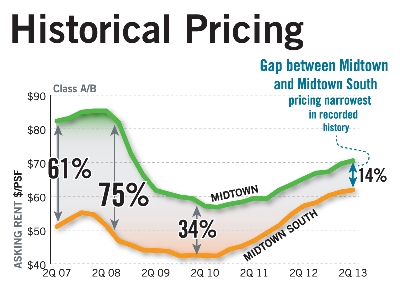Price Difference Between Midtown South and Midtown Narrowest in Recorded History
By Richard Persichetti July 23, 2013 7:00 am
reprints Midtown South rents continue to creep closer to Midtown’s. The difference between Midtown and Midtown South pricing for Class A and Class B space combined is 14 percent—the narrowest in recorded history. This is a substantial change compared with the third quarter of 2008, when the gap between the pricing for these two markets was at its widest, a 75 percent difference.
Midtown South rents continue to creep closer to Midtown’s. The difference between Midtown and Midtown South pricing for Class A and Class B space combined is 14 percent—the narrowest in recorded history. This is a substantial change compared with the third quarter of 2008, when the gap between the pricing for these two markets was at its widest, a 75 percent difference.
Back then, Midtown Class A/B average pricing was $35 per square foot higher than Midtown South’s. But today, at $70.58 per square foot, the Midtown Class A/B average asking rent is only $8.73 per square foot higher than the Midtown South Class A/B asking rent of $61.85.
Since asking rents bottomed for both markets in the third quarter of 2010, Midtown Class A/B pricing is up 24 percent; Midtown South outpaced that with a 46 percent increase over the same period. Midtown South still remains on fire, as it is the only market where all five submarkets have surpassed historically high pricing, while Midtown continues to lag. Class A/B average pricing for the three main Midtown submarkets (Fifth/Madison, Park Avenue and Sixth Avenue/Rockefeller Center) is still well off historically high rents. The exodus from the Avenue of the Americas corridor has kept pricing for Class A and Class B space in the Sixth Avenue/Rockefeller Center submarket 23 percent lower than its $102.13-per-square-foot historical high average from 2008.
But how long will it take for Midtown to catch up? In the second quarter of 2013, Midtown fundamentals started to pick up, and the Fifth/Madison submarket enjoyed a $6.71 per square foot increase—as I’m sure you remember from last week’s column—which puts that area 13 percent off of its historically high pricing. Additionally, absorption posted in the second quarter was positive 1.9 million square feet for Midtown as demand for space heated up.


